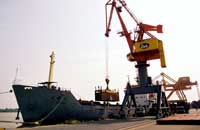
| Falling prices threaten shipping industry | |
Domestic shipping enterprises have been hit hard by the global financial crisis, which has led to shipping costs falling by 30 to 70 per cent. The Viet Nam Association of Ship Owners said the daily charge for leasing a 74,000-dead-weight-tonnage (DWT) ship, used for transporting rice, wheat flour, steel and fertiliser, had fallen during the past week from US$40,000 to $19,000. The price hit a peak three months ago, reaching a rate of $70,000 per day. Sea freight costs for container ships have also dropped to $500 for a 20-feet container, down from the previous price of $1,500. Some ship owners have accepted rates of $300 to $400 per container. Nguyen Quang Hung, managing director of Sunnytrans Transport Company, said the sea freight costs of large-capacity ships had fallen from $70,000 to $10,000 per day over a period of less than three months. General secretary of the Viet Nam Association of Ship Owners, Do Xuan Quynh, said the price cuts were a result of the global financial crisis. "Sea freight costs are at their lowest rate and cannot fall any further," said Quynh. Demand for shipping has fallen as companies around the world are tightening their spending during the fiscal storm. "The association has warned its member companies to cut prices, following record high rates in the third quarter in 2007 that it said could not be maintained," said Quynh. "However, the association could not predict such a great fall in prices." The rapid drop in shipping rates has presented a challenge to many sea transport enterprises in Viet Nam. Vu Huu Chinh, general director of Viet Nam Sea Transport Joint Stock Company (Vosco), said the company was having difficulties in collecting cargo for large ships. "Many ship owners in other countries have temporarily stopped operation of their ships to avoid huge losses due to the low sea freight rates," he said. Viet Nam Association of Ship Owners’ general secretary Quynh said shipping enterprises as well as related businesses were going through a difficult period. However, large shipping enterprises, including Vosco, Vitranchart and Vinaship, have not suffered too much from the falling rates. The worst hit are shipping companies that are relatively new, according to Quynh. "Because they have put a lot of investment into building ships without anticipating the huge price cuts," he said. "They have many ships but not enough cargo to transport." Quynh said shipping rates would only rise after the financial crisis comes to an end. Experts have said the difficulties for the shipping industry would continue as trade decreased. The import and export of goods in the next year may still decline due to the global financial situation. Due to these challenges, shipping companies would have to raise their competitiveness in the struggle for customers, leading to further falls in shipping rates. | |
| VNS |
